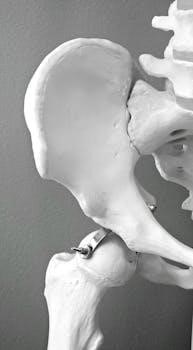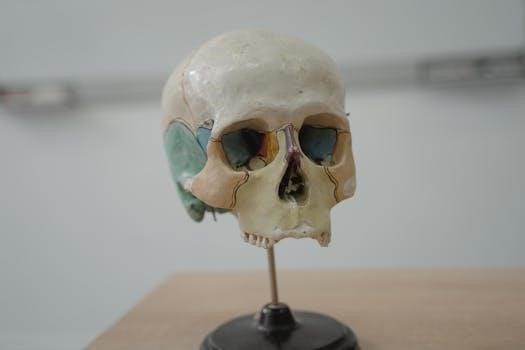Human anatomy explores the body’s structures and their relationships, while physiology studies their functions. These fields are intertwined, with structure dictating function. Resources like free PDF notes aid in studying these complex subjects, offering accessible learning materials.
Overview of Anatomy and Physiology
Anatomy, the study of the body’s structures, examines their morphology and relationships. Physiology, in contrast, delves into the functions of these structures, exploring how they operate. This includes understanding the processes from molecular to systemic levels. Together, they provide a comprehensive picture of the human body. Open educational resources and free PDF notes are designed to support this learning process by providing accessible study materials, enhancing the understanding of these subjects and making it easier to grasp the complex functions of the human body.
Levels of Organization in the Human Body
The human body has a hierarchical organization, starting with the chemical level, then progressing to cells, tissues, organs, and systems. Understanding these levels is essential for grasping the complexity of human physiology.
Chemical Level⁚ Atoms and Molecules
At the foundation of the human body’s organization lies the chemical level, encompassing atoms and molecules. These fundamental units interact to form the building blocks of all living matter. Genes, enzymes, and hormones, which are molecules, play crucial roles in cellular processes. Understanding this level is essential for comprehending the complex biochemical reactions that sustain life, as described in basic physiology resources.
Cellular Level⁚ Basic Units of Life
The cellular level represents the basic unit of all living things. Cells perform essential functions such as acquiring nutrients and oxygen, producing energy, eliminating waste, synthesizing molecules, responding to environmental changes and controlling material exchange. In multicellular organisms, cells specialize in specific functions. Free PDF notes on human anatomy and physiology often detail the diverse types and functions of cells.
Tissue Level⁚ Group of Similar Cells
At the tissue level, cells with similar structures and functions combine to form tissues. These tissues perform specific tasks within the body. Examples include connective, epithelial, muscle, and nervous tissues. Studying tissues is crucial for understanding organ structure and function. Human anatomy and physiology PDF notes frequently contain detailed information and illustrations of the various tissue types, and their roles.
Anatomical Approaches
Anatomical studies can be approached in different ways. These include examining large structures visible to the naked eye, focusing on specific body regions, or studying the body system by system.
Gross Anatomy (Macroscopic)
Gross anatomy, also known as macroscopic anatomy, involves the study of large body structures that are visible without the aid of a microscope. This approach allows for the observation of organs, muscles, bones, and other substantial components of the human body. Textbooks and pdf notes on human anatomy and physiology often include detailed images and descriptions for effective learning.
Regional Anatomy
Regional anatomy focuses on studying the body by specific areas or regions such as the head, neck, thorax, and limbs. It involves examining all the structures within a particular region, including bones, muscles, nerves, and blood vessels. This approach helps understand how different body parts work together in a specific area, making it easier for students using pdf notes and free resources.
Systemic Anatomy
Systemic anatomy, in contrast to regional, examines the body by organ systems like the skeletal, muscular, nervous, and cardiovascular systems. This method studies each system’s components and their functions throughout the body. Using systemic approach, free pdf notes and textbooks often organize content, which is ideal for learning about how different systems contribute to overall bodily functions.

Physiological Approaches
Physiology is studied using mechanistic and teleological approaches. Mechanistic explains how events occur, while teleological explains why functions exist, filling specific needs. Free PDF resources often cover these perspectives.
Mechanistic Approach
The mechanistic approach in physiology focuses on explaining the ‘how’ of bodily functions. It delves into the specific processes and mechanisms that cause physiological events. For example, it explores how a drop in body temperature triggers muscle contractions, leading to shivering. These details are often found in free PDF notes, which offer in-depth analyses of physiological mechanisms, aiding a deeper understanding of the body’s workings. This perspective emphasizes the direct cause-and-effect relationships within the human body.
Teleological Approach
The teleological approach, in contrast, explains the ‘why’ of physiological functions. It focuses on the purpose and need that a function fulfills within the body. For instance, it asks why we shiver – the answer being to keep the body warm. This perspective, often detailed in human anatomy and physiology PDF notes, emphasizes the overall goal of a function and its benefit to the organism. This approach looks at the bigger picture and reasons behind the body’s actions.

Basic Cell Functions
Cells perform essential functions like acquiring nutrients and oxygen, producing energy, eliminating wastes, synthesizing molecules, and responding to the environment. These processes, detailed in anatomy and physiology notes, are fundamental for life.
Nutrient and Oxygen Acquisition
Cells require a constant supply of nutrients and oxygen to sustain their functions. This acquisition process involves intricate mechanisms for uptake and transport. Oxygen is vital for cellular respiration, which provides the energy necessary for cellular activities. Nutrients are needed to synthesize essential molecules and maintain cellular structures. These processes, explained in human anatomy and physiology PDF resources, are fundamental for cell survival and overall body function.
Energy Production and Waste Elimination
Cellular activities demand a continuous production of energy, primarily through processes like cellular respiration. This process converts nutrients and oxygen into usable energy forms, releasing byproducts like carbon dioxide and water. Simultaneously, cells must efficiently eliminate waste products to maintain their internal environment. The mechanisms of energy production and waste disposal are critical for cellular health and are covered in detail in free PDF resources on human anatomy and physiology.
Molecule Synthesis and Environmental Response
Cells are dynamic entities capable of synthesizing a variety of molecules, including proteins, lipids, and carbohydrates, essential for their structure and function. They also respond to changes in their environment, allowing them to adapt and survive. This responsiveness involves intricate mechanisms for detecting stimuli and initiating appropriate cellular actions. Free PDF resources on human anatomy and physiology often highlight these complex processes in detail, offering a comprehensive understanding of cellular behavior.
Free PDF Resources for Human Anatomy and Physiology
Numerous free PDF resources are available for studying human anatomy and physiology. These include textbooks, lecture notes, and study guides, offering accessible learning materials for students and educators alike.
OpenStax Anatomy and Physiology
OpenStax provides a freely available, comprehensive anatomy and physiology textbook. This resource, licensed under CC BY, offers a complete overview of the subject, accessible for free download. It’s a valuable tool for students and educators, providing a solid foundation in the principles of human anatomy and physiology, and it is possible due to grant support from Oregon State University Ecampus.
Lecture Notes and Audio Scripts
Accompanying the study of human anatomy and physiology are lecture notes and audio scripts, often available as individual PDF files. These resources enhance learning by combining written material with auditory explanations. They include original images used in lectures, providing a comprehensive study aid. These resources greatly support students in understanding complex concepts in human anatomy and physiology.
Textbooks and Study Guides
Textbooks, such as “Essentials of Human Anatomy & Physiology,” along with study guides, are vital for in-depth learning. These resources often come in both physical and digital formats, aiding students in their studies.
Essentials of Human Anatomy & Physiology Textbook
The “Essentials of Human Anatomy & Physiology” textbook, now in its 9th edition, is a widely used resource for students. It provides a comprehensive overview of the subject and is available in both softcover and digital formats, often found in campus bookstores. The book has been a staple since 1989, reflecting a commitment to student needs in this field.

The Interrelation of Anatomy and Physiology
Anatomy and physiology are intrinsically linked; structure dictates function. Understanding this relationship is vital for comprehending how the human body works. Studying them together provides a comprehensive view.
Structure and Function Relationship
The relationship between structure and function is a cornerstone of understanding human anatomy and physiology. The way a body part is structured directly affects its function. For example, the thin walls of lung alveoli facilitate gas exchange. Conversely, the function of an organ shapes its structure over time. PDF resources often highlight this critical link through detailed diagrams and explanations, making it easier to grasp.

Systemic Approach to Studying Human Anatomy and Physiology
A systemic approach organizes the body into systems, such as skeletal or nervous. This method helps in understanding how different parts work together. Many free PDF resources utilize this framework for clarity.
Body Systems Overview
The human body comprises various interconnected systems, each with specific functions. These include the skeletal system for support, the muscular system for movement, the nervous system for communication, and the circulatory system for transport. Other vital systems are the respiratory, digestive, urinary, endocrine, and reproductive systems. Understanding each system is crucial, and free PDF notes often provide detailed overviews, aiding students in grasping the complexity of the human body and how these systems interact.
Importance of Human Anatomy and Physiology
Understanding human anatomy and physiology is crucial for medical and healthcare professions. It forms the basis for diagnosing diseases, developing treatments, and ensuring overall patient well-being.
Foundation for Medical and Healthcare Fields
Human anatomy and physiology serve as the bedrock for all medical and healthcare practices. A strong understanding of these subjects is essential for healthcare professionals to accurately diagnose illnesses, develop effective treatment plans, and comprehend how the human body functions in both health and disease. These disciplines provide the critical knowledge base necessary for medical advancements and patient care.
